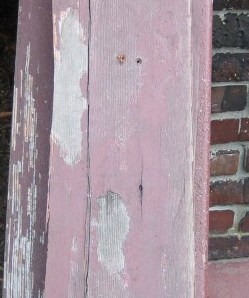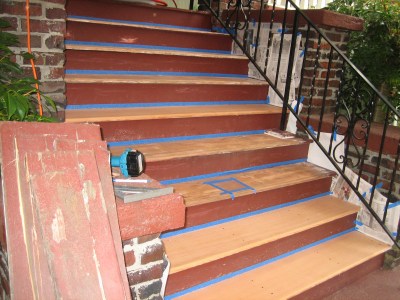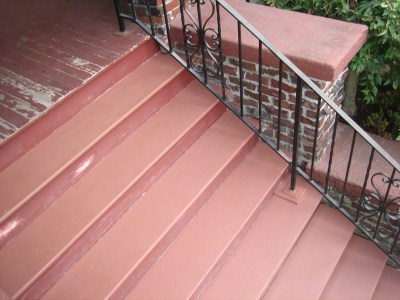
The Worst of The Worst Old Stair Treads
One of the many pleasures of no longer working for the man is that I can take on any home improvement project without any residual angst over the opportunity cost of doing manual labor versus my imputed hourly rate of compensation from my employer. All this makes me recall my meeting with Bill Evenden, the managing partner of the Seattle Andersen Consulting office, when I was in the process of resigning due to dissatisfaction with flying back and forth to a project in Dallas every week and the lack of quality time at home. He reflected "at some point in your career, you just start hiring someone else to mow your lawn and paint your house". I remember thinking "how emasculating"...and then "WTF, Bill Evenden, you live on a friggin houseboat. You have no lawn!"
Anyhoo, the front steps on our house have been a constant maintenance nightmare for the last 10 years. 10 years ago we had St. Aubin Painting and Construction paint our house and do some remedial caprentry., One of the items the completed was a full rebuild of the wood steps leading up to our porch. They did what looked like a nice job with 12" fir treads, primed on all sides and top coated with two coats of Kelly Moore Acry-Velvet, with sand mixed in for traction.
Horizontal painted surfaces that see a lot of foot traffic and are fully exposed to the weather are sure to have problems, and it wasn't too many years before we had lots of cracking and peeling paint on the steps. St. Aubin provided us with the leftover paint, so I started scraping, sanding, priming, and top coating every few years. But it just didn't last. Then I tried scraping, sanding, and using stain from Cabot, tinted to match the paint. The stain lasted better, but it didn't take the sand so didn't provide good traction, and since I left the paint in place where it wasn't peeling, I ended up with a patchy surface that continued to peel where the paint was still in place.
I want to note that I am not a shill for GacoShield, just a customer telling his story. I intend to come back to this page in upcoming years to document how well GacoShield is weathering in a tough application like mine.
Surface Preparation
This year I decided to bite the bullet and do the best darned job I could of fixing the problem, which for any painting project means intensive surface preparation. I scraped with my trusty carbide blade Sandvik scraper (I think I got it at Hardwick's), first alone and then with the aid of a heat gun. Boy that heat gun really works! I was able to get down to fully bare wood with its help. Then I took the belt sander and random orbital sander to everything to get the stain out and the last remnants of primer left by the scraper. I also completely replaced three treads that were cracking, which reduced my scraping effort, but at the cost of about $85 per tread...fir is not cheap!
I really recommend spreading the prep work over several days. I found that taking a fresh look at it after sleeping on it, I had a more critical eye for getting after the last few bits of paint and stain.
I diligently vacuumed, and used my air compressor to blow any remaining dust and fiber off the stairs before moving on to masking off the vertical edges and surrounding masonry.
One thing I love about these projects is I get to use my tools! Over the last 10 years I've acquired a bunch of nice tools that don't get used enough. They all worked great for this job. Out of all of them, I think I use my Fein shop vac the most. It is so quiet, and the filters keep my shop from being polluted with dust that otherwise would go out the exhaust. I also love my Milwaukee Super Sawzall and Superbar for any demolition project.
Product Selection
By far the toughest part of this project was selecting the product for finishing the stair treads.
I knew that plain old deck paint wasn't going to cut the mustard.
I considered an industrial pain such as Sherwinn-Williams sells for things like hospital floors and helicopter pads.
After doing some research on the thathomesite.com forums, I thought I was settled on sticking with Cabot stains, first laying down some Cabot Problem-Solver Deck Primer, then a solid stain. I knew this would be a solution that could be easily maintained by simply applying a new coat every few years, and that it wouldn't peel or crack. I would still have the challenge of traction since you can't really mix sand in with a stain, but I thought I could lay down some 3M adhesive backed traction strips. I hadn't really thought about the fact that when I re-stained in the future, I would either have to work around the traction tape, or remove it and apply new tape.
I went down to
Dunn Lumber to pick up my three new treads, where I was lucky enough to have Bob A. help me. Bob grimaced when he heard my plan to use stain, and told me his story of how he had finished his front steps' new treads 25 years ago with a product called
Spantex, and other than occasionally applying a new topcoat it had held up perfectly. He did stress the need to apply it to all surfaces, and that the initial application process was a bit complex. It sounded like a good solution if I was going to replace all of the treads, but I wasn't ready to do that. He also showed me a product called
GacoShield which I ended up purchasing after some hemming and hawing and additional research. At $75/gallon it was about half the cost of Spantex, and it had a one coat, no primer simple application process. Gaco also sells GacoGrip texture granules to mix in with GacoShield. Bob told me that the GacoGrip is just ground up walnut shells. The sample of the finished product looked pretty good, and the clincher was that one of their four standard colors is a very close match for our existing trim, including the front stairs. Often with these higher end finishes they only come in a couple of colors, and I didn't want tan treads with red trim.

Our Last Best Hope
I spent some time on the phone with Janice from Gaco. She was very helpful in answering my questions. I was concerned about whether GacoShield would work well for 12 inch stair treads since all of their collateral shows it being used on standard 4 or 6 inch decking. Since the big selling point of Gaco and Spantex is that they form a rubber-like membrane that stretches with cold and hot weather, I wanted to be sure it would work for my stair treads which are much wider (deeper) than standard decking.

Condensation Test
Janice assured me it was up to the challenge and could stretch "up to 200%". While I greeted this assertion with skepticism, I figured it only needed to stretch at most 10 to 15%. Janice cautioned me to be sure the wood was dry and told me to tape a piece of plastic to the wood and let it sit for an hour. If there is no condensation, then it is ready to paint.
I also asked about priming my new treads, and Janice reiterated what the product literature states, that no priming is necessary. "What about the underside and end grain?" I asked, and she said it should be left unfinished so the wood can breathe. She also stressed the fact that you need to put it on heavier than normal paint, and one gallon needs to be used for 100 square feet. So for my 8 treads that are 6 feet wide, I should use half a gallon.
Application

Ready for Paint
I wasn't buying Janice's advice about not priming. I couldn't see putting these beautiful new fir treads one foot above the dirt (bottom step) with zero protection, so I went ahead and put a light primer coat on the bottom side, end grain, and back edge. I used Killz because I had some from a previous project.
On the day I was painting, the weather forecast changed to call for some rain, so I erected a tarp over the work area.
I masked everything off and got rolling. After all of the prep work, the painting itself is very simple. I laid it on thick like the instructions indicated I should.

Looks Great, For Now!
In the end it looks great...just like all paint does immediately after application. Time will tell. I will post updates every 6 - 8 months with how it is wearing.
Status Updates
April 2010 The stairs weathered the winter just fine. It was a pretty mild winter however. No real snow or hard freezes. I am seeing signs of some cracks in one of the stair treads that I did not replace. Maybe I should have just replaced all of them. I really think the nails that the contractors used on them are the problem. But so far GacoShield is awesome. More updates to come in the future.